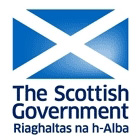Scottish National Dictionary (1700–)
Hide Quotations Hide Etymology
About this entry:
First published 1960 (SND Vol. V). Includes material from the 1976 and 2005 supplements.
This entry has not been updated since then but may contain minor corrections and revisions.
I, n.1, letter of the alphabet. The ninth letter of the alphabet, pronounced [ɑe], †[i:] (Bnff. 1836 in Ellis E.E.P. V. 777). In Sc., i is a front vowel having in gen. the same uses and values as i in Eng., though slightly more closed and longer in quantity, varying from high front tense to high front lax and including the diphthong pronounced according to the particular dialect and position in the word as [ɑe, ɑɪ; ai, aɪ (I.Sc.); əi]. See 3. below. In addition various Sc. dialects also pronounce i as a high or mid front lax lowered vowel [, ] or as a mid back tense vowel [ʌ] in certain positions, e.g.:
1. as [i]: (1) in the stressed vowel of Romance words as civil, city, image, item, licence, minute, oblige, position, etc. (see Weekly Mag. (18 July 1771) 69 and P.L.D. §45), and in the ending -ise, as criticeese, idoleeze, etc., now obsol.; (2) representing the development of O.E. i, y in open syllables through Mid.Eng. , as in Gie (give), Spier, Dreel (drill), Skeel (skill), Steer (stir); (3) in ne.Sc. in the ending -ie, -y, after a high or closed vowel in the root syllable according to the system of vowel harmony applying in that dialect (see Dieth §§ 83 sqq.); (4) in Chiel (child), King, wing, Sheen (shine) obsol., before [n(d)ȝ], as in Peenge, Reenge, Wheenge, and sporadically in local dialect pronunciations of forms borrowed from St.Eng. as pin [pin], swim [swim]. Since the 18th c. the spelling ee or, less commonly, ie has been largely adopted for this sound;
2. as [ɪ], representing mainly: (1) O.E., O.N. i, y without lengthening. Note that there is no lengthening of i in Sc. before -nd, -mb, unlike Eng., except in kind, mind, wynd, hence [fɪnd, grɪnd, blɪnd, klɪm, etc.]; (2) O.E. ō, O.N. ó, Fr. u, shortened, except when final and before r and voiced fricatives, to [ø, y] and from the early 18th c. onwards unrounded in e. and wm.Sc. to [ɪ], though the spellings u-e, ui, and, formerly, anglicised oo are usu. retained (see P.L.D. §86, §93.1, §96.1), e.g. Brither, Ither, Fit, Mither, Guid, Mune, shune, spune, Uise, n. [′brɪðər, fɪt, etc.]; (3) O.E. u, esp. freq. before or after dentals, e.g. Hinnie, Nit, Pit (put), Simmer, Sindrie, Wid (see P.L.D. §60.1); (4) an unstressed vowel, usu. orig. e, as in pa.p. of wk. verbs, creepit, dreidit, hurtit, luikit, etc.; in his (has, O.Sc. hes), wis (was, O.Sc. wes), div (Dae, v.1), hiv (Hae), wir (= our), kin (can), Is (as), Ir (are); in wm. and s.Sc. in the adj. ending -ie, -y (cf. 1. (3) above); (5) earlier a, ai, e before -nt in ne.Sc., e.g. wint (want), pint (paint), kint (kent, knew), Inter (enter); (6) freq. before v, as Iver, Ivery, Ivenoo.
In most Sc. dialects however this sound [ɪ] is modified by lowering in some way (see P.L.D. §58, §59): (1) to [] in ne.Sc. before voiceless consonants, single nasals, l and r, e.g. as in fish, Fit, Clim, Rin, fir, Birl, Gird, Licht adj.1, n.1, v.1 and Licht adj.2, n.2 and v.2; (2) to [, ] in I. and sn.Sc. in most positions, and also in s.Sc. except before [] where it becomes [i] (see P.L.D. §107, §118.2, §164.7). [], written i, also develops in s.Sc. from O.E. (h)ā- by a process of breaking into [′iə > ɪ′ɛ > j], hence Yill (ale), yin (Ane), yit (Ait), hyim (Hame), hyill (Hail, adj.); Cf. also Stell, n.2, a still. (3) to [ʌ] in e. and wm.Sc. in sim. positions (see P.L.D. §90, §95.2 (1) and cf. Fif. 1845 Stat. Acc.2 IX. 42; also in most dialects after w, wh (f in n.Sc.) (see P.L.D. §59), e.g. will, win, witch, whip, whiskie, whistle [wʌl, wʌn, etc.]; in ne., e. and wm.Sc. before -l, e.g. fill, hill, til, [fʌl, hʌl, tʌl] (see P.L.D. §58.1) and -kl-, -tl- -k(e)n- as in Chucken; as in Pickle, little [pʌkl, lʌtl]. Muckle is Gen.Sc. See on the above A. Scott The Contrast (1779); (4) to [e] in the ending -ie, -y, reg. in em.Sc. (b) (cf. P.L.D. §89 and -Le, suff.) and in ne.Sc. after open back vowels as Bonnie [′bone] (see 1. (3) above).
3. as the diphthong developed mostly from O.E. ī, , O.N. í, ý, O.Fr. i, viz. [əi, s.Sc. i], written i-e, y-e, †ay, †ey, but finally, and in n.Sc. before voiced fricatives, [ɑe] as in buy, dry, Kye, and among old speakers in n.Sc. in a rounded form [ʌi] as in bide, hoyne s.v. Hyne, mine, five, pipe [bʌid, mʌin, etc.] (see P.L.D. §131 and A. Scott The Contrast (1779)). But see also 1. (1).
The diphthong [əi, in nn.Sc. ei] also (1) develops in some words before g, as big, pig, rig, in nn.Sc., ne.Sc. (coast), Fif., ‡n.Rxb. (see P.L.D. §107, §147.1 (4)), and before ng, nk, in Fif. (see P.L.D. §87); (2) represents Mid.Eng. oi, ui, O.Fr. ui, mod.Eng. oi, in boil, oil, joint, point, in n. and m.Sc. and now also freq. in s.Sc. Obs. exc. dial. in Eng. In Dundee, Fife and some districts of Edinburgh the sound [ < i] is heard for the diphthong [ɑe] as in I, my, pie, etc.
For the digraphs in which i occurs, viz. ai, ei and ie, oi, ui, see the letters A, E, O, U respectively.
You may wish to vary the format shown below depending on the citation style used.
"I n.1". Dictionary of the Scots Language. 2004. Scottish Language Dictionaries Ltd. Accessed 18 Dec 2025 <http://www.dsl.ac.uk/entry/snd/i>


